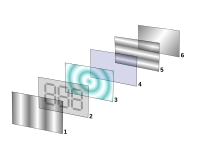Liquid-crystal display

A liquid-crystal display (LCD) is like a mini television screen that can show things like pictures, videos, and texts.
Inside the LCD, there are lots of tiny light bulbs called pixels, and each pixel has three colors: red, green, and blue. These are the primary colors, and you can mix them to create any color you want.
Each pixel has a thin layer of liquid crystal, which is like a tiny door that opens or closes to let light pass through. When an electric charge is sent to the liquid crystal, it twists and the door opens or closes, letting the light through or blocking it.
The LCD has thin layers of glass on both sides, and the pixels are sandwiched between them. On one of the glass layers, there is a special grid that controls the electric charge sent to each pixel, telling it how much to twist and open or close the door.
When you turn on your LCD screen, a light behind it shines on the pixels, and the ones that are open and letting the light through create the images you see. The grid tells each pixel how much of each color to let through, creating the image with millions of tiny dots.
The LCD screen is very useful because it is thin, light, and doesn't use as much energy as older screens. It's used in many devices like phones, laptops, GPS systems, and even some cars.
Inside the LCD, there are lots of tiny light bulbs called pixels, and each pixel has three colors: red, green, and blue. These are the primary colors, and you can mix them to create any color you want.
Each pixel has a thin layer of liquid crystal, which is like a tiny door that opens or closes to let light pass through. When an electric charge is sent to the liquid crystal, it twists and the door opens or closes, letting the light through or blocking it.
The LCD has thin layers of glass on both sides, and the pixels are sandwiched between them. On one of the glass layers, there is a special grid that controls the electric charge sent to each pixel, telling it how much to twist and open or close the door.
When you turn on your LCD screen, a light behind it shines on the pixels, and the ones that are open and letting the light through create the images you see. The grid tells each pixel how much of each color to let through, creating the image with millions of tiny dots.
The LCD screen is very useful because it is thin, light, and doesn't use as much energy as older screens. It's used in many devices like phones, laptops, GPS systems, and even some cars.
Related topics others have asked about:
